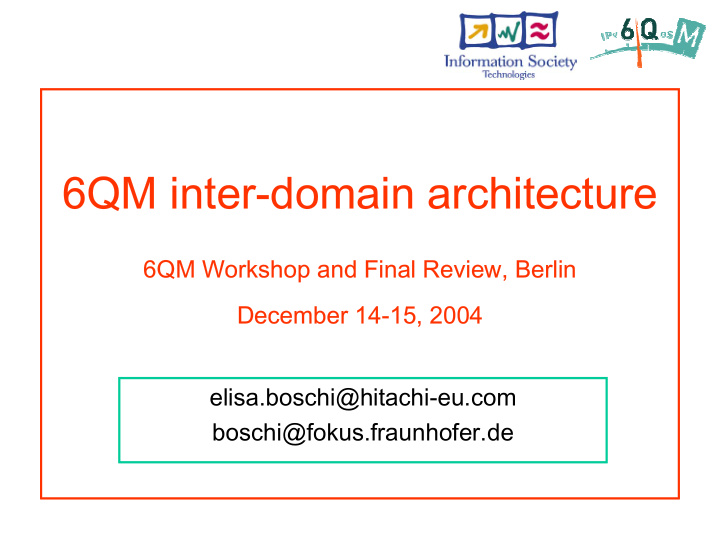



6QM inter-domain architecture 6QM Workshop and Final Review, Berlin December 14-15, 2004 elisa.boschi@hitachi-eu.com boschi@fokus.fraunhofer.de
OUTLINE • Need for End-to-End measurements • Requirements • Monitoring configuration • Data export • 6QM architecture • Components in detail • Security (AAA)
E2E measurement END START G F I C H2 A H1 B AS3 AS4 AS2 AS1 “Each domain” monitor its network and knows the next step… H1 only knows: - the destination of the flow - the management point of its …but not details of the other networks domain
Inter-domain measurement requirements • Common data format – How to compare data – IPFIX • Configuration protocol – How to share data among ISPs – SMS • Common measurement framework and common metrics – Measurement tools are often ISP specific – OpenIMP and most of all common metrics • And of course: cooperation between ISPs!
Monitoring configuration • Specification of Monitoring Service (SMS) • The configuration process splits the document into a – Intra-domain SMS – Inter-domain SMS sent to “next hop” • Different configuration granularity
SMS – ID – Scope source – destination (changing every time) – SRC controller – Collector – Flow identification filter (Complex field) – Metric – Time schedule – Report schedule – Periodically – At the end of the monitoring process – In alarm mode (notification threshold) – Random mode – Real time mode – Custom mode – Reporting document type {IPFIX template , Custom, …} – Options • Sampling – Method – parameters • Completeness • Refinement • Random shipment • Overload behaviour • Flow expiration (given time interval, FIN or RST bit in a TCP connection)
SMS splitting src: GUI SMS ID: X scope: A.1 � C.6 X1 X2 (A.1 � A.2) (B.3 � C.6) local forwarded B 3 4 SMS X4 SMS X SMS X2 B.4 � C.6 A.1 � C.6 B.3 � C.6 2 C 5 src: A SMS ID: X2 A 1 6 scope: B.3 � C.6 X3 X4 (B.3 � B.4) (C.5 � C.6) local forwarded
Nested SMSs ID SMS ID: 1.1 Scope • Source ID SMS ID: 1 • destination Scope • SMS ID: 1.1 SRC controller • SMS ID: 1.2 Collector Flow identification SRC controller Metric pkt header Time schedule Collector Report schedule Flow identification Reporting document type Options Metric OWD - Granularity: endpoint Time schedule Report schedule ID SMS ID: 1.2 Scope Reporting document type • source Options • destination - Granularity: endpoint SRC controller Collector Flow identification Metric pkt header Time schedule Report schedule Reporting document type Options - Granularity: endpoint
Data export IPFIX IPFIX SMS controller meter
6QM initial functional architecture Results Other domains... Inter-domain Controller + Collectors Requests Get IPFIX data User 6QM Evaluator 6QM Measurement Manager Interface GUI Store control & Calculate Monitor meters Store result management Info Generate task Control IPFIX Collector Data Flow Active Meter Active Meter Passive Meter Passive Meter capture generate generate capture analyze analyze capture capture analyze analyze Test packet WAN LAN LAN User traffic
CONTROLLER SMS Management SMS interpreter tables SMS forwarder CORE SECURITY CONTROLLER CHECKER AAA server Measurement management
COLLECTOR Exporter DATA (IPFIX) Collector and SMS DATA (IPFIX) copies composer IPFIX DATA (local)
AAA 2 REQUEST AAA (A) AAA (B) 5 K ISP B ISP A 3 1 6 4 CONTROLLER CONTROLLER DATA (K) COLLECTOR COLLECTOR 7 8 DB
Thank you…
Recommend
More recommend